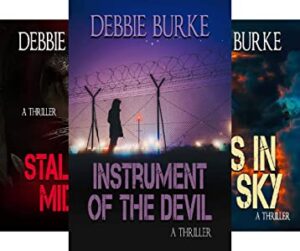by Debbie Burke

Photo credit: Allan Warren, Creative Commons license
I use the cigar for timing purposes. If I tell a joke, I smoke as long as they laugh and when they stop laughing I take the cigar out of my mouth and start my next joke. – George Burns
Note: Today’s discussion concerns later drafts when you rewrite, edit, and polish. It doesn’t apply to first drafts where the main job is to get the story down.
~~~
I love the great old comedians like George Burns and Gracie Allen, Jack Benny, Groucho Marx. They not only knew WHAT to say to make the audience laugh, they knew WHEN to say it. They were masters at timing.
Johnny Carson freely admitted, when he was starting out, he blatantly copied Jack Benny—the gestures (elbow in hand, hand on cheek), the pauses, the deadpan stares.
These guys knew how to tell a joke: introduction, buildup, suspenseful pauses, more buildup, and, at last, the climax of the joke known as the punchline.
According to Masterclass.com:
Where Did the Punchline Originate?
Punchlines in jokes can be traced back a long way, but the term “punchline” first came onto the scene in the early twentieth century. While it is usually attributed to the British humor magazine Punch, the term itself was first used by a Wisconsin newspaper, The Racine Journal News, in 1912, when a review of a play described a “punch in every line.”
The New York Times talked about “punch lines” the following year. “Punchline” then gained traction and usage in reference to performances and finally appeared in the Merriam Webster Dictionary in 1921.
Classic comedians can teach authors a lot. After all, what are jokes but tightly compressed stories that have a beginning, middle, and end?
Both comedians and authors introduce a situation, one or more characters, and a problem. Events unfold. Certain key clues are withheld. Suspense builds. At the end comes the Big Reveal—the PUNCHLINE in a joke or the CLIMAX in a novel.
As authors, we are concerned with macro issues: plot, character development and story arc.
Today, though, let’s focus instead on micro issues. By this, I mean individual sentences, paragraphs, and scenes with special attention to word order and timing.
In How to Write a Mystery (an excellent book I reviewed recently), Hank Phillippi Ryan writes:
…Even though you’re writing a whole book, each page must be a perfect part of your perfect whole, and that means each individual page must work.
Think of a paragraph like a joke. Although the content doesn’t have to be funny, the delivery is similar. It needs an introduction, building action and suspense, then a mini-climax that propels the reader into the next paragraph.
One paragraph leads to the next, with more building action and suspense, then another mini-climax.
Put a bunch of paragraphs together and they become a scene.
Combine a bunch of scenes and they turn into a chapter.
Stack up those chapters and you eventually have a book.
Let’s examine sentences since they are the building blocks on which the entire story rests. If you start with solid sentences, you’re more likely to create good paragraphs, scenes, and chapters.
What makes a good sentence?
Clarity. The meaning should be understandable on the first read.
Direct and active;
Has a purpose in the story;
Concise.
What shouldn’t be in a sentence?
Description for description’s sake;
Pointless thinking or musing by a character;
Excess verbiage or fluff.
Confusing elements;
Long, overly-complicated, or convoluted phrasing.
When you rewrite, examine each sentence, word by word.
When you read it aloud, does it flow smoothly? Are there places where you stumble?
Is there a stronger verb or noun you can use?
Are there filler words you can cut without changing the meaning?
Consider the order of the words in the following example:
Ed plopped on the couch and popped the top on a beer that he’d just bought when he drove to the liquor store. He’d been arguing with Mary all morning. She claimed he was drinking too much.
Meh.
Hard to follow because the events are out of chronological order. The “punchline” is buried. Nothing pulls the reader into the next scene.
The argument about drinking too much is actually the first event that starts a chain reaction. Ed and Mary argue. He drives to the liquor store, buys beer, comes home, and starts drinking to thumb his nose at Mary’s concerns.
If this example were a joke, the punchline is buried near the beginning.
The paragraph ends with a whimper, not a bang.
Rewrite:
Ed was fed up with the constant arguments. Why did Mary keep trying to control him? He stormed out the door, drove to the liquor store, and bought a twelve-pack of Rainier. Back at home, he plopped on the couch. When Mary entered the living room, he grabbed a can. “Hey, honey, listen to this.” He popped the top.
The same information is conveyed. However, the sentences are shorter; the chronological order is rearranged for clarity; the punchline is at the end.
The punchline also serves as a mini-cliffhanger hinting their argument is about to escalate.
The reader turns the page to find out what happens next.
Ideally, each paragraph is part of a 250 to 300-page chain reaction that continuously builds to the ultimate explosion of the story climax.
Our goal as writers is to make the strongest dramatic impact on the reader. By carefully rearranging words, sentences, paragraphs, and chapters, you build suspense and impel the reader to turn the page.
My first drafts are full of long, convoluted sentences and thick, dense paragraphs. Events happen out of order and don’t make much sense, except to me.
All right, sometimes they don’t make sense, even to me!
That’s because I write things in the order that they occur to me. A clue or line of dialogue pops into my mind. I write it down quick before I forget it. That means many words and phrases are in the wrong place.
Of all the tech advances since the dawn of word processing, cut-and-paste is my favorite. It makes editing and polishing far easier than the old-fashioned scissors and tape method. It allows quick and easy rearrangement of words and sentences.
While editing, the writer discovers:
The snappy comeback on page 23 works better in the dialogue on page 12.
The description of the grungy no-tell motel needs to be moved from page 64 back to page 33 when the motel is first shown.
The revelation about the cause of the hero’s scar should be delayed to the midpoint to increase reader curiosity.
As you polish later drafts, consider what the reader needs to know and when they need to know it at any given moment in the story.
In mysteries, we direct suspicion at different characters. We plant clues that don’t seem to have meaning until later chapters.
We mislead the reader with red herrings (although it’s important to play fair or the reader will get angry at being duped).
A revelation unexpectedly pivots the plot in a different direction the reader didn’t expect, resulting in a surprise.
The following video appeared in a previous post. It’s worth watching again because it’s a terrific example of suspense building, perfect timing, and a punchline that delivers a wallop.
Good timing results in the greatest dramatic impact on the reader.
For old-time comedians (and good contemporary ones like Dan Yashinsky), timing is crucial.
The same is true with storytelling.
~~~
TKZers: Do you consider timing when you write? Do you have suggestions how to achieve more dramatic effect?
~~~

Black Friday through Cyber Monday Sale. All Tawny Lindholm Thrillers are only $.99 from November 26 through November 29.


